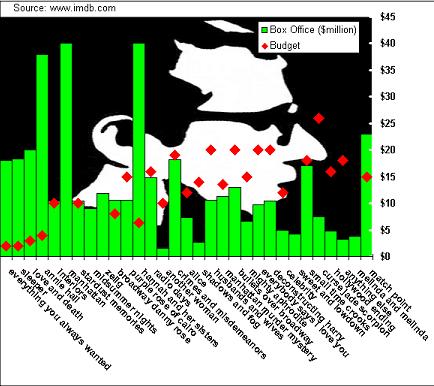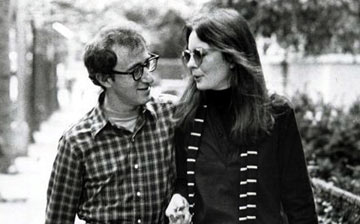Taking One's Muses to the Bank
posted by The Chair
Reviewing the recent blog entries and meeting minutes suggests that the ESI’s will only get their collective stride if they have a muse – be it 5th or anyone else. I suppose one shouldn’t be surprised. Great artists from time immemorial have required such accoutrements to inspire their creativity.
But choosing the right muse makes all the difference. Take Woody Allen, for instance. I recently rented Mr. Allen’s latest flick, Match Point, which stars the ever-lovely Scarlett Johansson (from Lost in Translation fame). Though she denies the rumours of being Woody’s latest muse, Ms. Johansson is playing the leading role in his next movie, Scoop. But times are different now. First off, there is nothing resembling any off-screen romance that pretty much set the precedence for Diane Keaton and Mia Farrow. As far as I know, Soon-Yi Previn is still his off-screen sidekick since she changed her relationship status with Woody from “stepdaughter” to wife in the 1997.
I recently rented Mr. Allen’s latest flick, Match Point, which stars the ever-lovely Scarlett Johansson (from Lost in Translation fame). Though she denies the rumours of being Woody’s latest muse, Ms. Johansson is playing the leading role in his next movie, Scoop. But times are different now. First off, there is nothing resembling any off-screen romance that pretty much set the precedence for Diane Keaton and Mia Farrow. As far as I know, Soon-Yi Previn is still his off-screen sidekick since she changed her relationship status with Woody from “stepdaughter” to wife in the 1997.
Regardless, Woody’s onscreen muses have pretty much defined his cinematic career. But have the muses generated the box-office results? Since the early eighties, with the exception of 1986’s Hannah and her Sisters, Woody Allen movies have been money-losing ventures. There are competing theories as to why he can’t turn a buck anymore. The main theory is that he doesn’t have to. It’s all about the art. I think there is some truth to that. When movies like The Bodyguard can make over $100 million, one doesn’t need to look any further for answers. Another theory is that, at least since 1992 when things got creepy (rumour is that Mia Farrow found nude photos of her, then 22-year-old, adopted daughter in Woody’s apartment) his fan base has dwindled for moral reasons. I have friends -- mostly women -- who will not go see his movies anymore. A final theory, well one I have anyway, is that he hasn’t found a muse equivalent to the golden days of Diane Keaton (from Play it Again, Sam to Manhattan). I fell in love with her character in Annie Hall and no one has matched that high point yet.
Using the powers of statistical analysis I decided to test these three competing theories.
Methodology
The first test was to look at the ratings of Woody’s movies and specifically the relationship between box office draw and critical acclaim. If a critic liked the movie but the same film lacked box-office appeal, it would support the “I’m-in-it-for-the-art” theory, and moreover, why Adam Sandler with a magic remote control is playing at a theatre near you. To explore the “boycott-the-diddler” theory, I would analyze the returns of Woody’s movies pre- and post-period of the said event. The final test examines the box office returns for Mr. Allen’s films from the Diane Keaton versus the Mia Farrow period.
To use a consistent source of critical review I relied on Roger Ebert’s assessment using a 4-star scale. Where Ebert did not have a review rating, I relied on consensus results from similar critics (only 4 alternate sources were required). To measure the impact of Keaton, Farrow, and the “diddle-factor”, I employed the use of dummy variable analysis in a multiple regression linear analog commonly used in multi-variate analysis.
Results
First off, the art theory can be immediately dismissed. If Roger Ebert didn’t like the movie, the results were significantly negative at the box-office. Every additional star Ebert gave an Allen movie generated an extra $6 million. The diddle-factor was definitely a negative attribute but it was highly negatively collinear with the Mia Farrow factor, which makes sense since she stopped making movies with him once he started snogging her daughter. Analysis of the Mia period pre-diddle compared to the post-diddle period indicates that the diddle-factor was indeed negative, lopping about $2.5 million dollars of a typical box-office receipt. To look exclusively at the Keaton versus Farrow effect, an analysis isolating the diddle factor and Ebert’s review was undertaken. The results clearly indicate that in the pre-diddle period, Keaton’s presence on the screen added about $4.7 million to typical box office take whereas Ms. Farrow’s presence reduced the take by about $8 million. The results showed no Ebert preference for either Ms. Farrow or Ms. Keaton, or any evidence of Ebert having any bias in his ratings post-1992 as a result of the salacious details of Woody’s family situation. In fact, he showed only a slight bias towards favouring films starring Ms. Farrow, yet this was neither significant nor material enough to change the negative box-office impact of her screen presence.
The results showed no Ebert preference for either Ms. Farrow or Ms. Keaton, or any evidence of Ebert having any bias in his ratings post-1992 as a result of the salacious details of Woody’s family situation. In fact, he showed only a slight bias towards favouring films starring Ms. Farrow, yet this was neither significant nor material enough to change the negative box-office impact of her screen presence.
In conclusion, Mia was a huge negative effect, and more than twice the negative impact than anything subsequently attributed to Woody sleeping with her daughter. Overall, the combined effect cut his box-office take roughly in half.
Which brings me back to Ms. Johansson. Match Point is the first moneymaker for Woody Allen in over 15 years. If I were his financial backer, I would say stick with this muse. On the plus side, Ms. Johansson, at 21 years of age and still single, is probably at least a decade away from having any children that would be of interest to Woody. By that time, no one will care either way. More likely, she’ll probably be Adam Sandler’s muse in Click IV: Batteries Not Included. That’s just the way Hollywood works.











3 comments:
Will The Chair entertain questions?. I am, after all, a methodiddleogical coyote.
First, is there any need to adjust for movies in which Mr. Allen actually appeared, as opposed to those, such as Match Point, in which he did not? I'm wondering if there may be some kinda difference between the ones where couples are age-appropriate, as in the above; and ones where one partner is 17 and the other is a stuttering, frizzy-haired, fifty-ish elf with horned-rim glasses. Not that I'm judging, or anything.
Second, considering the alleged rampancy in the film industry of alleged 'creative accounting', so studios can avoid taxes and also avoid paying alleged residuals to those who are allegedly entitled to them, how d'ya test for the proposition that only the films you've listed as doing so, actually ended up on the credit side of the, er, alleger?
Interesting stuff, Chair. But if y're seeking independantish verification of yer results, y'should provide a chart or table with these purported "star" ratings.
Also - is Ebert really a critic? I like his reviews because if he likes a movie, I'll probably like it.
Meanwhile, if I like a movie, you'll probably think it's "trite derivative crap".
Perhaps y'should use the New Yorker for your critic's baseline.
You make a point, Short Guy. But why the New Yorker? We coyotes swear by Video Hound's Golden Movie Retriever 'cuz insteada stars, it rates flicks with bones. And a real dog of a movie, naturally, with a 'Woof!'.
Post a Comment